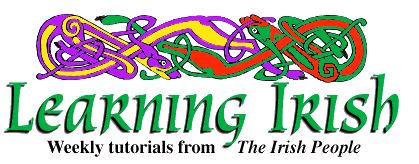
Irish Lesson 45
|
This week we will review the vowel "e". Without a síneadh fada (SHEEN-uh FAH-duh) over it, "e" usually has the sound of "e" in English "let". When "e" is at a word end, the sound may resemble (uh), but pronounce it as a short (e), without emphasis. Examples: baile (BAHL-e), mise (MISH-e). With a síneadh fada, the letter is é, pronounced like the first part of the English sound in "may", without the final (ee) or (i) that you will detect if you say "may" very slowly. We use (ay*) as a symbol for the Irish sound. Remember how Irish persons close to the Irish language pronounce English words like "railroad, rate, lane, made". The sound is that of é (ay*). In Irish, the sound is held longer than in English. When inside a word, "e" without a síneadh fada is almost always followed by "i". The sound is still (e), as in deir (der), peil (pel), or deich (de).
Pronunciation Exercise
Read this passage slowly without looking at the key below it. Then read it a second time, making use of the key if you are unsure. Do not try to make sense of the words; concentrate on the pronunciation and on grouping the words into phrases; D'fhulaing an oiread sin stop a chur le scaipeadh a bhí san am i seilbh na Fraince gach fear de na gasraí a bhuail mé le mo dhuine. Fuarthas i bpictiúr eile céadta punt i gcás a bhformhór ina bhfuil cur síos ar an oileán a bheidh ar an socrú a tharla ar an mbaile sin ocht mbliana d'aois faoin chomhlachtaí príobháideacha.
DUDU-ling un IR-uhd shin stohp uh k*ur le SKAHP-uh vee suhn oum i SHKL-iv nuh FRAN-ke gahk* far de nuh GAHS-ree uh VOO-il may* le muh GIN-e. FOO-uhr-huhs i bik-TYOOR EL-e KAY*D-tuh poont i GAW*S uh vohr-uh-VWOHR nuh vwil kur shees er un IL-aw*n uh ve er un SOHK-roo uh HAHR-luh er un MAHL-e shin ohk*t MLEE-uh-nuh deesh fween K*OH-luhk*t-ee pree-VAW*-duhk*-uh.
Grammar
For indirect speech, of which: John says that they are at the door is an example, the forms "go" and "nach" follow the first verb and its subject when the second verb is in the present. An example: Deir Seán go bhfuil siad ag an doras (der shaw*n goh vwil SHEE-uhd eg un DUH-ruhs), John says that they are at the door. In the past tense, "tá" and a few of the other irregular verbs require "gur" (gur) and "nár" (naw*r) before them. Read these three examples over carefully until you understand the principle of sentence formation with past tense indirect speech:
Dúirt Seán go raibh siad istigh (DOO-irt shaw*n goh rev SHEE-uhd ish-TEE), John said that they were inside. Chuala Máire go bhfaca mé an carr (K*OO-luh MAW*-re goh VAH-kuh may* un kahr), Mary heard that I saw the car. Dúirt mé gur chaill sí a cóta (DOO-irt may* gur k*eyel shee uh KOH-tuh), I said that she lost her coat.
Here are the irregular verb forms in the past for indirect speech: go bhfaca mé (goh VAH-kuh may*), that I saw. nach bhfaca mé (nahk* VAH-kuh may*), that I didn't see. gur chuala mé (gur K*OO-uh-luh may*), that I heard. nár chuala mé (naw*r K*OO-uh-luh may*), that I didn't hear. go bhfuair mé (goh VOO-ir may*), that I got. nach bhfuair mé (nahk* VOO-ir may*), that I didn't get. go ndúirt mé (goh NOO-irt may*), that I said. nach ndúirt mé (nahk* NOO-irt may*), that I didn't say. go ndearna mé (goh NYAR-nuh may*), that I did. nach ndearna mé (nahk* NYAR-nuh may*), that I didn't do.
gur thug mé (gur hug may*), that I gave. nár thug mé; that I didn't give. gur rug mé air (gur rug may* er), that I seized him. nár rug mé air; that I didn't seize him. gur tháinig mé (gur HAW*-nig may*), that I came. nár tháinig mé; that I didn't come.
go ndeachaigh mé (goh NYAK*-hee may*), that I went nach ndeachaigh mé; that I didn't go go raibh mé (goh rev may*), that I was nach raibh mé (nahk* rev may*), that I wasn't
Drill
Make up a simple sentence, such as "He said that I saw him", or "he believes that I saw him", for each of the above twenty phrases. The first part of the sentence can be such as these: Deir sé (der shay*), he says; dúirt siad (DOO-irt SHEE-uhd), they said, is dóigh liom (is DOH-ee luhm), I think; etc. Next, combine the negative of the irregular verbs in the past and present with regular and irregular forms. To start, take "Feicim go raibh ____" (FEK-im goh rev), I see that ____ ; "Ní fhaca sé go raibh ____ " (nee AH-kuh shay* goh rev), he didn't see that ____ ; "Feicim nach raibh ____" (FEK-im nahk* rev), I didn't see ____ was not. Next, work on the regular verbs in the past tense with indirect speech. Make sentences to complete these sentence starts: Is dóigh liom, with: that he bought a house; that he didn't buy a house; that he explained the story (scéal (shkay*l)); that he didn't explain the story. Shíl mé (heel may*), I thought, with: that they understood it; that they didn't understand it; that they lost the money; that they didn't lose the money.
(c) 1998 The Irish People. May be reprinted with credit. |